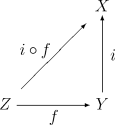Subspace topology
In topology and related areas of mathematics, a subspace of a topological space X is a subset S of X which is equipped with a topology induced from that of X called the subspace topology (or the relative topology, or the induced topology, or the trace topology).
Definition
Given a topological space and a subset of , the subspace topology on is defined by
That is, a subset of is open in the subspace topology if and only if it is the intersection of with an open set in . If is equipped with the subspace topology then it is a topological space in its own right, and is called a subspace of . Subsets of topological spaces are usually assumed to be equipped with the subspace topology unless otherwise stated.
Alternatively we can define the subspace topology for a subset of as the coarsest topology for which the inclusion map
is continuous.
More generally, suppose is an injection from a set to a topological space . Then the subspace topology on is defined as the coarsest topology for which is continuous. The open sets in this topology are precisely the ones of the form for open in . is then homeomorphic to its image in (also with the subspace topology) and is called a topological embedding.
A subspace is called an open subspace if the injection is an open map, i.e., if the forward image of an open set of is open in . Likewise it is called a closed subspace if the injection is a closed map.
Terminology
The distinction between a set and a topological space is often blurred notationally, for convenience, which can be a source of confusion when one first encounters these definitions. Thus, whenever is a subset of , and is a topological space, then the unadorned symbols "" and "" can often be used to refer both to and considered as two subsets of , and also to and as the topological spaces, related as discussed above. So phrases such as " an open subspace of " are used to mean that is an open subspace of , in the sense used below -- that is that: (i) ; and (ii) is considered to be endowed with the subspace topology.
Examples
In the following, represents the real numbers with their usual topology.
- The subspace topology of the natural numbers, as a subspace of , is the discrete topology.
- The rational numbers considered as a subspace of do not have the discrete topology (the point 0 for example is not an open set in ). If a and b are rational, then the intervals (a, b) and [a, b] are respectively open and closed, but if a and b are irrational, then the set of all x with a < x < b is both open and closed.
- The set [0,1] as a subspace of is both open and closed, whereas as a subset of it is only closed.
- As a subspace of , [0, 1] ∪ [2, 3] is composed of two disjoint open subsets (which happen also to be closed), and is therefore a disconnected space.
- Let S = [0, 1) be a subspace of the real line . Then [0, 1/2) is open in S but not in . Likewise [½, 1) is closed in S but not in . S is both open and closed as a subset of itself but not as a subset of .
Properties
The subspace topology has the following characteristic property. Let be a subspace of and let be the inclusion map. Then for any topological space a map is continuous if and only if the composite map is continuous.

This property is characteristic in the sense that it can be used to define the subspace topology on .
We list some further properties of the subspace topology. In the following let be a subspace of .
- If is continuous the restriction to is continuous.
- If is continuous then is continuous.
- The closed sets in are precisely the intersections of with closed sets in .
- If is a subspace of then is also a subspace of with the same topology. In other words the subspace topology that inherits from is the same as the one it inherits from .
- Suppose is an open subspace of (so ). Then a subset of is open in if and only if it is open in .
- Suppose is a closed subspace of (so ). Then a subset of is closed in if and only if it is closed in .
- If is a basis for then is a basis for .
- The topology induced on a subset of a metric space by restricting the metric to this subset coincides with subspace topology for this subset.
Preservation of topological properties
If a topological space having some topological property implies its subspaces have that property, then we say the property is hereditary. If only closed subspaces must share the property we call it weakly hereditary.
- Every open and every closed subspace of a completely metrizable space is completely metrizable.
- Every open subspace of a Baire space is a Baire space.
- Every closed subspace of a compact space is compact.
- Being a Hausdorff space is hereditary.
- Being a normal space is weakly hereditary.
- Total boundedness is hereditary.
- Being totally disconnected is hereditary.
- First countability and second countability are hereditary.
See also
- the dual notion quotient space
- product topology
- direct sum topology
References
- Bourbaki, Nicolas, Elements of Mathematics: General Topology, Addison-Wesley (1966)
- Steen, Lynn Arthur; Seebach, J. Arthur Jr. (1995) [1978], Counterexamples in Topology (Dover reprint of 1978 ed.), Berlin, New York: Springer-Verlag, ISBN 978-0-486-68735-3, MR 507446
- Willard, Stephen. General Topology, Dover Publications (2004) ISBN 0-486-43479-6